This step by step woodworking project is about how to build a garden chair plans. This article features detailed instructions for building a beautiful garden chair. The best part of this project is that you can build the outdoor chair in just a weekend. I have designed the plans to keep the expenditures under control and to involve the least amount of work possible. This is the matching chair that should fit perfectly the double chair bench project. If you want to build a project for your front porch this is the one that should be on top of your list.
When buying the lumber, you should select the planks with great care, making sure they are straight and without any visible flaws (cracks, knots, twists, decay). Investing in cedar or other weather resistant lumber is a good idea, as it will pay off on the long run. Use a spirit level to plumb and align the components, before inserting the galvanized screws, otherwise the garden chair won’t have a symmetrical look. If you have all the materials and tools required for the project, you could get the job done in about a day. See all my Premium Plans HERE.
Projects made from these plans
It’s that simple to build your DIY outdoor chair!
How to Build a Garden Chair
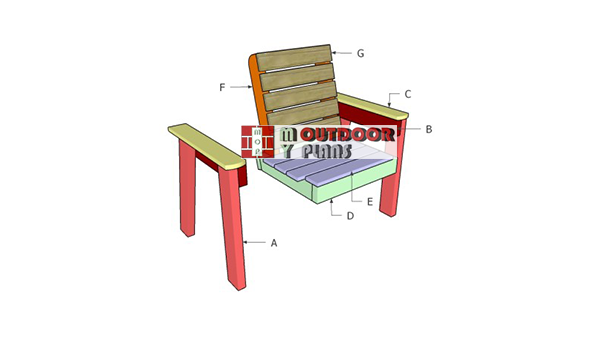
Building-a-garden-chair
Cut & Shopping Lists
- A – 2 pieces of 2×4 lumber – 23″ long, 2 pieces – 24 3/4″ long LEGS
- B – 2 pieces of 2×4 lumber – 21 3/4″ long SUPPORTS
- C – 2 pieces of 1×4 lumber – 22 1/4″ long ARMRESTS
- D – 2 pieces of 2×4 lumber – 22″ long, 2 pieces – 18″ long FRAME
- E – 4 pieces of 1×4 lumber – 22″ long SEAT
- F – 2 pieces of 2×4 lumber – 24″ long BACKREST SUPPORTS
- G – 5 pieces of 1×4 lumber – 19″ long BACKREST
- 3 pieces of 2×4 lumber – 8′
- 3 pieces of 1×4 lumber – 8′
- 2 1/2″ screws
- 1 5/8″ screws
- filler, stain
- protective finish
- paint brushes
Tools
![]() Hammer, Tape measure, Framing square, Level
Hammer, Tape measure, Framing square, Level
![]() Miter saw, Drill machinery, Screwdriver, Sander
Miter saw, Drill machinery, Screwdriver, Sander
Time
![]() One day
One day
How to build a garden chair
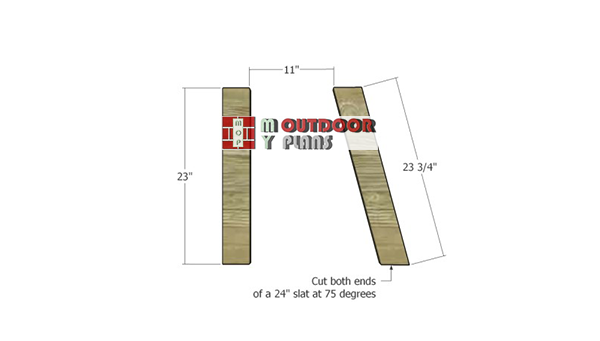
Building-the-chair-legs
The first step of the project is to build the legs for the garden chair out of 2×4 lumber. Cut both ends of the back legs at 75 degrees by using a miter saw. Smooth the cut edges with sandpaper, to get a professional result.
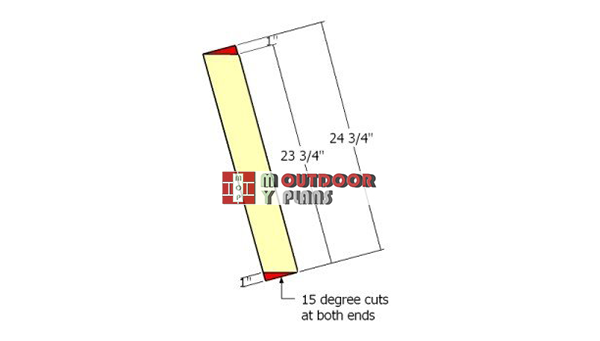
Back-legs-plans
Cut the back legs using the information from the diagram. Take accurate measurements for a professional result. The easiest way to get accurate angle cuts is by using a miter saw.
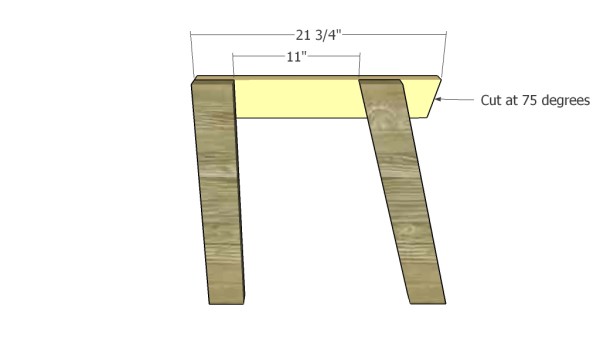
Fitting the armrests supports
Next, attach the top support to the legs, as described in the diagram. Cut one end of the supports at 75 degrees and lock them to the legs using 2 1/2″ screws. Add glue to the joints and make sure there are no gaps between the components. Make sure the corners are square when attaching the supports.

Building the seat frame
Build the seat frame out of 2×4 lumber. Cut the components at the right dimensions, using the information described in the diagram. Cut one end of the supports at 75 degrees. Drill pilot holes and insert 2 1/2″ screws to lock everything together tightly.
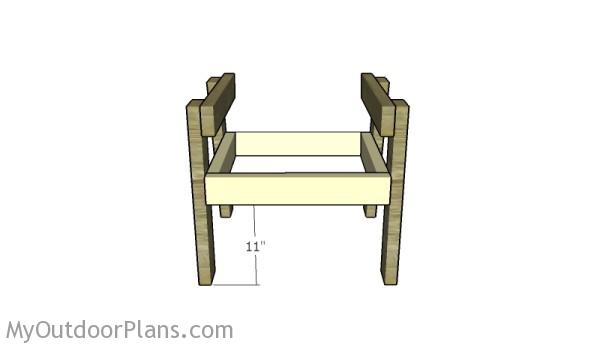
Fitting the seat frame
Fit the seat frame to the sides of the garden chair. Drill pilot holes through the frame and insert 2 1/2″ screws into the legs. Use a square to make sure the corners are right-angled. Use a spirit level to make sure the legs are plumb and to check if the seat frame is horizontal.

Building the backrest supports
Build the backrest supports out of 2×4 lumber. Round one corner and smooth the edges with sandpaper. Use any curved shape you find in your shop to draw the line. Anything starting with a can up to a paper tape roll should work perfectly.
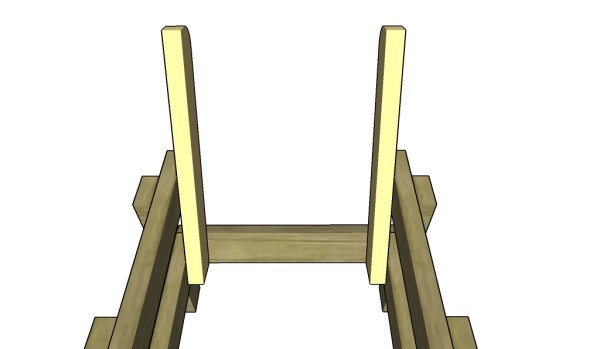
Attaching the backrest supports
Fit the supports to the back of the chair, as described in the diagram. Drill pilot holes and secure the supports to the frame using 2 1/2″ screws. Use galvanized screws, as the chair will most likely be exposed to the elements.

Fitting-the-seat-slats
Fit 1×4 or 2×4 slats to the seat frame. Place a 1/2″ wood block between the slats to create consistent gaps. Drill pilot holes and insert 1 1/4″ screws for the 1×4 slats and 2 1/2″ screws for the 2×4 slats.
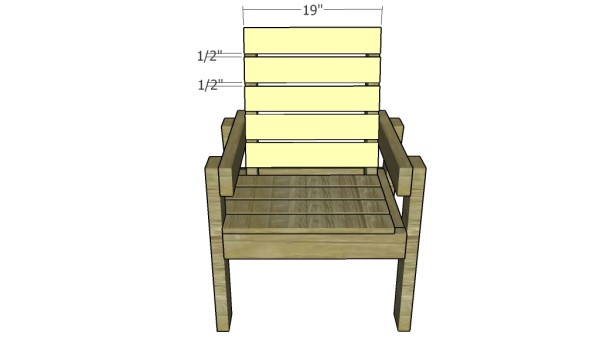
Fitting the backrest slats
Continue the project by fitting 1×4 or 2×4 slats to the backrest supports. Place a 1/2″ spacer between the slats to create even gaps. Drill pilot holes before inserting the galvanized screws to prevent the wood from splitting.
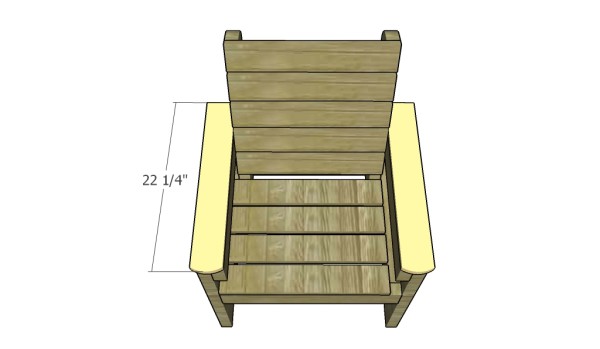
Attaching the armrests
One of the last steps of the project is to build the armrests and to attach them into place. Round one end of the armrests using a jigsaw and smooth the edges with sandpaper. Use glue and 2″ brad nails to secure the armrests to the outdoor chair.
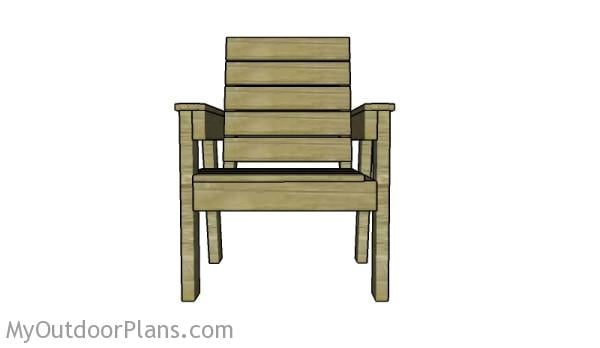
Outdoor chair plans
This is a sturdy chair, so you don’t have to worry about that when choosing the right design for you. In addition, the square lines and the minimalist look will make it an elegant addition to any patio or deck. If you liked this project, don’t forget to take a look over the double chair with table project.
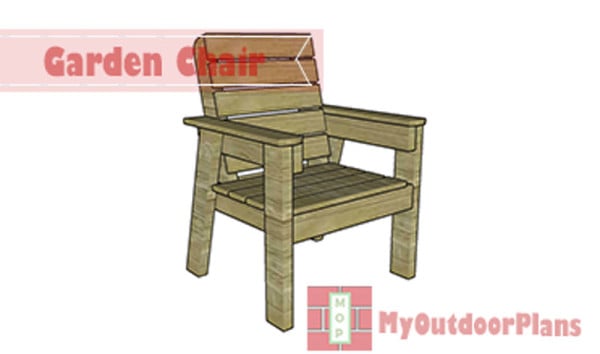
Garden-chair-plans
One of the last steps of the woodworking project is to take care of the finishing touches. Therefore, fill the pilot holes with wood putty and smooth the surface with 120-grit sandpaper. In addition, you can use a router to round some of the exposed edges for some extra appeal.
Top Tip: If you want to enhance the look of the project and to protect the wooden garden chair from decay, I recommend you to cover the components with paint or stain.
This woodworking project was about how to build a garden chair plans. If you want to see more outdoor plans, we recommend you to check out the rest of our step by step projects. LIKE us on Facebook and Google + to be the first that gets out latest projects and to hep us keep adding free woodworking plans for you.

8 comments
I noticed that there was no mention of a measurement for the seat frame from the bottom of the legs? I assume that it is the same for the Double Chair Bench w/Table at 11″??
Thanks and love the site!
Hey Brent! Thank you for the nice words and for stopping by. Nice catch… you have to leave 11″ from the ground to the seat frame. Good luck with your project and let me know how it turns out!
Hi Julian, Thank you very much for this additional plan to go with the Double Chair Bench with Table. All of our plans are very easy to follow and very well Illustrated.
Thank you for the feedback, Ray. Looking forward to seeing your projects.
Could you please give a materials list im not to good at figuring this stuff out
Thank you
Hi thanks for plans , what we’re the 6 extra 8” pieces of wood
for?
Kind Regards
Kath
What 8″ pieces?
I’ve built a handful of these chairs. My family is tall so the dimensions of the chair with these plans is a little narrow and the seat is slightly short for us. So I increased the seat width and depth by 3″ and increased the back height by 3″ as well. I also made sure the seat in back was dropped by 1.5″ so there was some incline. Those changes made the next set of chairs much more comfortable for us.